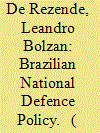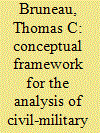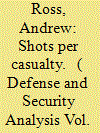|
|
|
Sort Order |
|
|
|
Items / Page
|
|
|
|
|
|
|
| Srl | Item |
| 1 |
ID:
163095


|
|
|
|
|
| Summary/Abstract |
With the world’s ninth largest economy and comprising nearly 60% of South America’s GDP, 47% of its territory, and 49% of its population, Brazil has become a regional power and an important actor in world affairs over recent decades. This scenario has led the government to re-evaluate its role in the world order, resulting in the enactment of the National Defence Policy, whose objective was to consolidate the country as a regional power while at the same time addressing national security issues, promoting economic development through a series of defence programmes, restructuring the defence industrial base, fostering innovation through technology and knowledge transfer to Brazil, and indigenous research and development. However, the policy’s implementation suffers from several challenges discussed in this article, which may test the capability and competence of Brazilian policymakers, military, industrialists, and other individuals and organisations involved in its implementation.
|
|
|
|
|
|
|
|
|
|
|
|
|
|
|
|
| 2 |
ID:
163093


|
|
|
|
|
| Summary/Abstract |
The article argues that current conceptual approaches in civil-military relations are deeply flawed resulting in its irrelevance in analyzing major issues including war and the collapse of democracy. After highlighting major flaws in the work of the late Samuel Huntington and those who follow his approach, the article argues that other conceptual approaches, including Security Sector Reform, are also flawed, or in the case of the “military effectiveness” literature, largely irrelevant. In explaining the main causes of the flawed conceptual literature, the article highlights the absence of good data and challenges in methodology. While arguing that military forces are very unlikely to engage in armed combat, it highlights the roles and missions which in the world today are implanted by these forces. As it is virtually impossible to prove effectiveness of the armed forces in these roles and missions, the article proposes a conceptual approach based on requirements.
|
|
|
|
|
|
|
|
|
|
|
|
|
|
|
|
| 3 |
ID:
163094


|
|
|
|
|
| Summary/Abstract |
Romania faced one of the most dramatic transitions from authoritarian communism to become a democracy and a member of the North-Atlantic Treaty Organization (NATO) and the European Union (EU). The backbone of building a democratic society has been civilian control of the military. This article briefly describes the norms and institutions of democratic control of the intelligence services in Romania and assesses how the mechanisms of democratic control have worked in practice after almost three decades of reform. We argue that many of the post-1989 reforms have been only superficial implemented and monitored, particularly after Romania joined NATO and the EU. The article concludes that the democratic control of intelligence in Romania is an unfinished business. There are structural shortcomings embedded in the process of democracy consolidation that need to be addressed.
|
|
|
|
|
|
|
|
|
|
|
|
|
|
|
|
| 4 |
ID:
163096


|
|
|
|
|
| Summary/Abstract |
In combat, the ratio of shots fired per casualty inflicted can provide a measure of the combat effectiveness of a force. The shots per casualty ratio achieved by the 1st Australian Task Force in Vietnam is shown to change according to factors including marksmanship, tactics and combat type. While, over the course of the campaign, 1ATF fired an increasing number of shots to achieve a casualty, this is explained by improvements in the quality of Viet Cong and People’s Army small arms. Australian Task Force and US Army shots per casualty ratios are briefly compared..
|
|
|
|
|
|
|
|
|
|
|
|
|
|
|
|
| 5 |
ID:
163092


|
|
|
|
|
| Summary/Abstract |
The slow moving conflict in the South China Sea has been characterized by some as “not worth the candle.” China claims the entirety of the South China Sea pursuant to a nine-dash line, the legal impact of which has been limited by international courts. At the same time, China has changed the reality of control over the South China Sea by building a number of fortified islands in the Spratly Islands and elsewhere. The US has either refused to stand up to China's behavior (Obama) or responded unevenly (Trump). This paper examines the impact of China's behaviour on local parties, US interests, and the liberal international system.
|
|
|
|
|
|
|
|
|
|
|
|
|
|
|
|
|
|
|
|
|